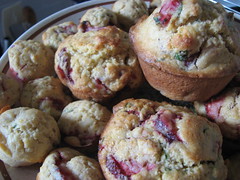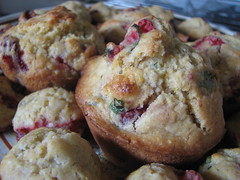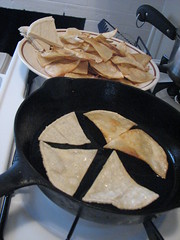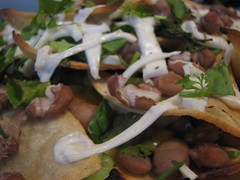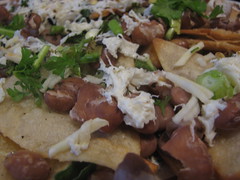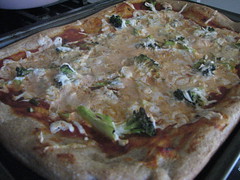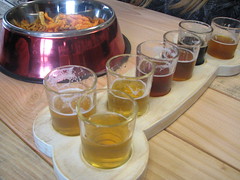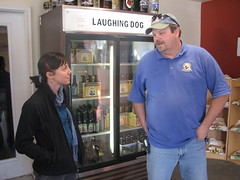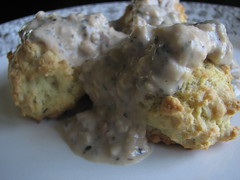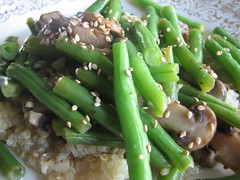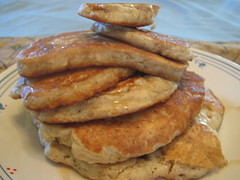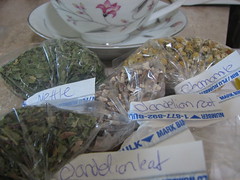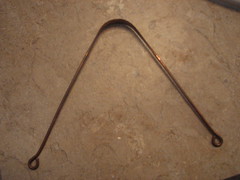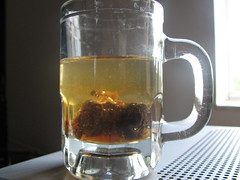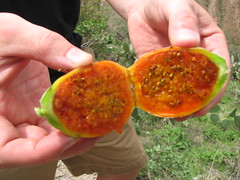After fighting multiple colds since returning from South America, my husband and I have decided to add a few days of eating raw before we continue with a liquids fast. I don’t understand if we have a build-up of toxins from the produce in South America or if we are adjusting to new germs in the US. Regardless, we could use a cleanse.
Unfortunately, we are not in a “green” zone, like Seattle. We are in Florida. At the local farmer’s market, I asked a vendor if he used sprays or pesticides on their produce. I got an “I don’t know” from one and a laugh from the other. Apparently, seeking produce sans chemicals is not in demand or the supply at the farmer’s markets. I was shocked to see apples from Washington and grapes from Chile at the market. Guess “local” is not in demand, either. I don’t want anyone to take offense, I am just observing the differences between my experiences in Seattle’s markets versus the markets I’ve visited in Florida. We did find a nut and dried fruits guy at the market that had raw, organic nuts at a good price.
So the raw idea came about because I want to learn more about raw cuisine and want to practice. I used the highly recommended Ani Phyo’s Raw Food Kitchen as my intro to raw foods. She has a lot of good information about green living as well as eating. I was excited to try her recipes. Some of the recipes we liked, others were blah. We did 5 days of raw foods and survived. Overall, it was not difficult but a lot of prep and washing the food processor and blender. I was in the kitchen for hours making the dishes, which was too much for me. I assume you spend less time as you learn more, but it seemed like it was more time to un-cook than to cook. I found it difficult to make some of her recipes without a dehydrator or a $400 Vita-Mix blender. I have been trying the oven drying method (turn your oven on, turn your oven off, wait, repeat) and the bread took about 14 hours to dry. I would do sun-drying but I am in muggy Florida. I think it would just add moisture to my food and rot it. We spent about $175 on food for 5 days of raw for 2 people (we did end up with some leftovers). $60 of that was just nuts. Nuts are expensive and it was intense to eat so much fat in the form of nuts and olive oil (she calls for a lot in the recipes). Her serving sizes are HUGE, which left us with more food than we could eat.
Why raw? There are many schools of thoughts on raw, and the one I am learning about is vegan raw foodism. The concept is to consume food that is “live” and not heated over 104 deg F (although people do have different opinions about the temperature thing). The main benefits of eating raw is for increased energy, improved health (prevention and healing of disease) and benefits of anti-aging. When food is cooked, there is a loss of vitamins and water. Juliano says that cooking in metal pans means we are consuming toxic metals as well. It’s very cleansing and high in fiber. Not all raw folks are 100% raw, there are many people who choose percentages of raw/cooked that work for them. I have always found raw cuisine fascinating and fun. I’ve enjoyed trying new raw places, my current favorite is Almond Blossom Cafe in Flagler Beach, FL. They blew me away with great flavors, textures and presentation. I always feel great after eating a raw meal and a little hyped on energy.
I didn’t really notice any detox feelings while on the raw diet. I missed bread and chocolate and beans. The main thing that my body noticed was the high level of fats in the food and the lack of carbs. I personally don’t consume a lot of carbs, but zero was a little extreme. I like fat like everyone else, but I was overwhelmed by the amount of olive oil in the soups and salad dressings.
Now on to the recipe reviews. I think Ani has done great and beautiful things with raw food and I don’t want to offend, just offer my personal opinion.
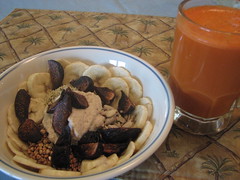
Hemp Muesli.
For breakfast, we tried the Hemp Muesli and the Spanish Scramble. The buckwheat crispies were delicious, but took a long time to dry out in my oven. The muesli mixture was tasty and balance in terms of texture. I made the Almond Yogurt to go with it but was not impressed with the yogurt. It was really thick and gritty (no Vita-Mix). Instead, I watered it down and added some honey and sea salt and turned it into a milk and it was much better. The portion for the muesli was perfect. I also made the Pumpkin Mylk to go with the muesli and really liked it. I used less water than called for in the recipe.
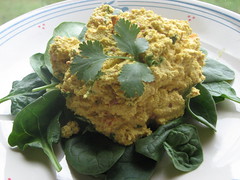
Spanish Scramble.
Another breakfast we had the spanish scramble, which is nut-based. I added more water than the recipe called for. It looked great, the portion was too big and it was really filling with lots of chewing. The texture got old after a few bites. The flavor was little bland. It needed a kick, like more cilantro or salt. Perhaps a VM would have helped out here as well. Overall it was too fatty for me in the morning.

Save the Tuna Pate; Thai Salad.
Tuna Salad: Ate as a wrap. It was okay. The texture was right on for mock-tuna, but the flavor was lacking salt. I doubled the dulse flakes and wished I added more. Matt hated it. The Thai Salad was delicious and a fun balance of herbs and greens. The dressing was really oily. I think with a little less oil it would be really good. I didn’t have Kaffir lime leaves. I used Meyer lemon leaves.
Burrito: This was a favorite meal for both of us. Apparently so good I forgot to take a picture. The nut meat is great, but perhaps too much salt. The baja cheese was weird but it went fine in the burrito. Matt really wanted it on a tortilla shell; the cabbage leaves were not cutting it for him. I thought it was fun. The corn salsa was delicious and tasty and perfect.

Ginger Almond Nori Rolls.
Ginger Almond Nori Rolls: Interesting. Raw nori is a little too fishy for my palatte. Matt liked it a lot. The pate had a lot of salt and lemon in it, making it “fishy”. I used julienned carrots instead of the gobo and a variety of sprouts instead of pure mung beans. Fun texture, good flavors, but not for me. I apparently have a thing with seaweed, sometimes I love it, sometimes I hate it.

walnut garlic soup.
Walnut Garlic Soup: I used 2.5 cups of water instead of 4. I wished I used less oil, too. It was too oily and hard to eat with that much fat (not to mention there are oily walnuts and avocadoes in it). I blended the dill with the soup. It was nice and creamy and I loved the avocadoes in it.
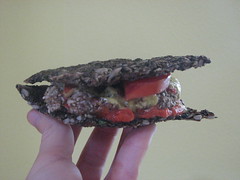
Sun Burgers.
SunBurgers: Definitely add the lettuce and tomato and a lot of catsup and mustard. It is bland alone. The bread was hard to make but tasted good. The catsup was too sweet for me. The mustard was awesome. I used a little less oil for that one. The burger itself was fine, but nothing amazing. This meal involved a lot of chewing, which got tiring. I think a dehydrator would have helped a lot for the bread and the burger.
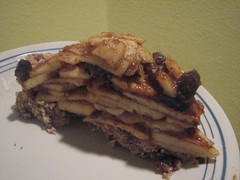
Apple Pie.
The apple pie was awesome! I think if I had a mandoline to slice it would have been better with thin slices. Raw seems to need a lot of machinery. I really wanted to do the noodle dishes, but I needed a spiral slicer to get it right. Gourmet raw does require a bit of investment. I sliced the apples as thin as I could and it was worth it. We looked forward to the pie every night.
We also made (not pictured) the Sweet Spicy Pecans which were really spicey. I would do cayenne to taste. But it’s a great tasty snack. The Portabello Bisque was good, except that it was too watery, oily and salty. If I made it again I’d do half of the salt and oil and add water until it’s the texture I like. The ceviche style mushrooms were delicious. The curry salad was wonderful. I used less oil and water in the dressing and it was delicious. I would make that dressing again.
In summary, I didn’t love it nor did I feel full of energy. If anything the high fat content made my appetite decrease. Funny that when I eat at a raw restaurant I feel different. Maybe 5 raw days is different than 1 meal here and there. Everyone’s bodies need different things, but I will not pass it aside. There are many benefits to eating this way, and I will try to incorporate it into my usual diet, just not 100%. I still have a number of recipes in the cookbook marked and want to try them out when I have time (and the money) to do it.
